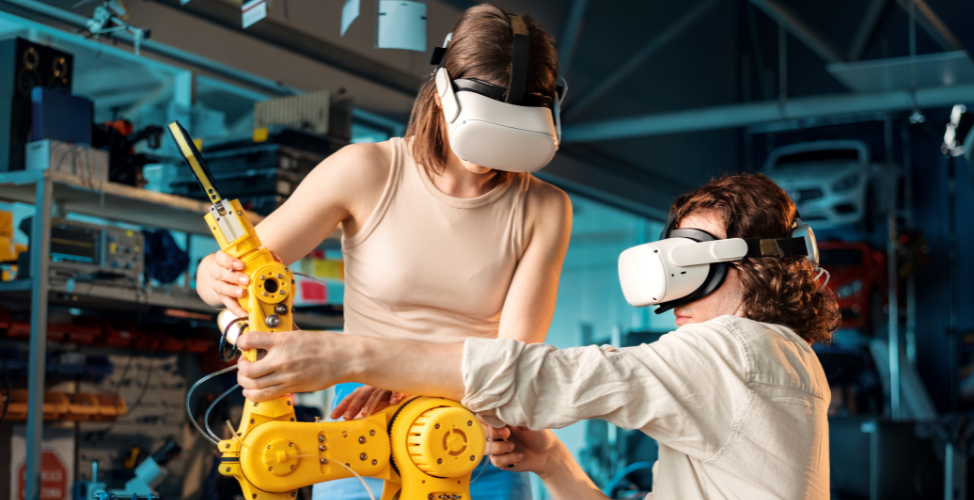Generative AI for Retail: Raising Personalization and Engagement
Shoppers crave personal touches and quick help. That craving grows bigger each year. Retailers look for smarter ways to meet those wishes. Generative AI for retail has a key role in that quest. It builds fresh ideas, content, and interactions using patterns gleaned from past data. Retailers turn to it when they want to ‘wow’ shoppers and keep them coming back. Yet many still ask how it works, why it matters, and what it takes to do it well. This blog walks you through those points.

Below, we’ll break down how generative AI powers unique shopping journeys, boosts loyalty, and shapes what’s next. You’ll also see its risks like data privacy and biased training. From hyper-personalized campaigns to smart gadgets and supply chains, it’s all here. We’ll even touch on future plays with AR, VR, and scaling. Let’s go!
What is Generative AI?
Generative AI is a branch of machine learning that produces original outputs like text, images, or even video after learning from existing data. It might craft product photos, fill customer queries, or build brand-driven ads. Traditional AI focuses on classification, detection, or recommendations. This new wave goes further. It ‘imagines’ and ‘creates’ new content. That skill sets it apart in the retail world.
Generative AI for retail acts like a supercharged team member who analyzes your entire warehouse, product catalogs, and customer buying trends—all in seconds. It then creates fresh email pitches, catchy product taglines, or even design concepts and marketing visuals tailored to your audience. This creative power enables retailers to launch unique products and messages that truly stand out, even in a crowded, competitive market.
Some people worry that “new content” from AI means random guesses, but that’s far from the truth. In reality, the AI relies on patterns it has learned from massive datasets, using those insights to generate polished, on-brand output. This pattern-driven approach—rooted in key AI terms like machine learning and natural language processing—is exactly why many retailers embrace it. They see it as a powerful tool to capture attention, streamline operations, and keep their brand relevant in a competitive market.
How Generative AI Raises Personalization and Engagement
Generative AI guides retailers toward building deeper bonds with customers. Generative AI for retail can tailor marketing, power helpful chatbots, and spark new ways to connect in person and online. The AI finds trends, suggests improvements, and organizes content that speaks to each shopper’s tastes by analyzing customer data. Here are a few ways it helps:
Hyper-Personalized Marketing
Old marketing campaigns often toss the same message at everyone. Many shoppers ignore those because they don’t feel personal. Generative AI changes that approach. It uses each user’s habits, what they searched for, and their past orders. Then it shapes a marketing email or site banner that points out the exact items they are likely to want. This shift gets people to open more emails, click more often, and place more items in their cart.
Picture a shopper who loves active wear. The AI might detect that pattern and send them a note: “We’ve got new running shorts in your size. Order them by tonight for a special discount.” That nudge feels personal and timely. Another example is an apparel shop that uses AI to design social ads. The ads show items the shopper viewed last week, paired with short text that captures their style or color preference. That small detail can boost clicks and sales. People tend to act more when they see a personal touch.
Hyper-personalized marketing can also help with timing. The AI might suggest when someone is most likely to look at an ad, or prefer an SMS message. Some brands call these ‘smart blasts.’ This approach helps them save on marketing costs, since messages land when folks have a higher chance of engaging.
Virtual Shopping Assistants
Brands aim to respond quickly to questions, day or night. Virtual shopping assistants handle that job without burning out. They sit on a retailer’s site or mobile app, waiting for customers to type or speak questions about stock, shipping, or product details. Instead of reading a generic script, they tap into generative AI to adapt and speak in a brand’s style.
With generative AI for retail, chatbots do more than just answer questions—they can deliver witty responses, suggest add-on products, and clearly explain return policies. They continuously learn from past interactions to improve future conversations. For example, if a shopper once asked about eco-friendly packaging, that detail might be highlighted the next time they visit. This personalized, always-on experience builds stronger customer loyalty—like having a tireless team member who never sleeps and always remembers what matters most to each shopper.
One example is a furniture brand that uses a chatbot to handle dimension queries, color advice, or extra add-ons like cushions. The bot may say, “You said you like warm styles. Here’s a set of rugs that pair well with that sofa. Want me to show them?” This kind of personal conversation speeds up decisions. Shoppers rarely guess. They see the brand as supportive, even from a distance.
Raised In-Store and Online Engagement
Some folks mix digital transformation and physical shopping. They might try on shoes at a store, check color variants on the website, then finalize the purchase in an app. Generative AI helps unify those steps. By analyzing real-time data, the AI can see what the shopper liked in the store, then send them a sweet online coupon within hours. This approach merges channels so the shopper feels that the brand recognizes them in every place.
On the in-store side, it might power augmented reality or interactive screens. People can hold an item in front of a display and get suggestions or see its origin. A grocery chain, for instance, can use this smart tech to let customers ‘scan’ a pack of coffee. On a screen, it might show a quick story about the coffee farm, tasting notes, or pairing ideas. This blend of storytelling and product detail moves customers from curious to sure. They no longer see an ordinary shelf item. They see a unique coffee with a story.
Online, it can rearrange the site layout in real time, factoring in who is browsing. If a shopper often hunts for deals, the homepage might highlight daily specials. Another shopper who loves premium ranges might see a curated selection of new arrivals. This approach spares them from rummaging through clutter and shortens the path to purchase. That leads to happier customers and fewer bounces.
Challenges and Considerations in Putting Generative AI
While generative AI for retail brings many upsides, it’s not perfect. Retailers must watch out for issues around data use, fairness, and system blending. Below are some key points:
Data Privacy and Security
Using personal details to power this AI model calls for strong data rules. If the system stores addresses, payment info, or purchase patterns, it must keep them guarded at all times. Shoppers trust retailers to use their data in safe ways. A breach can erode that trust overnight. Secure encryption, frequent audits, and restricted data access are all must-haves.
Retailers should also practice data minimization. That means collecting only the details needed to meet business goals. Over-collecting might help the AI, but it raises the risk of exposure. We live in a time where data hacks pop up daily. So a healthy approach is to store less, but do it well. If your generative AI approach requires outside providers, double-check their compliance track record.
See more: 10 Real-Life AI in Marketing Examples and Use Cases
Bias and Accuracy in AI Models
Generative AI models only mirror what they’ve absorbed. If the training data leans toward certain preferences, or excludes some segments, the AI results can reflect bias. That might lead to odd product suggestions or marketing that leaves out entire groups. Retailers should test their AI outputs for bias in language and content. If you see questionable patterns, revise the training sets or adjust the model.
Accuracy can also slip. The AI might ‘hallucinate’ or produce flawed info. Shoppers might see product descriptions with the wrong color or fabric name. That confusion can cause returns or negative feedback. So keep a human in the loop. Monitor AI outputs and fix mistakes early on. Over time, your data and training improve, and the AI grows better.
Linking with Old Systems
Many retailers still rely on legacy back-end software, which often doesn’t integrate smoothly with generative AI tools. This disconnect creates an integration gap that slows down data exchange and prevents real-time updates. In the context of AI digital transformation, this becomes a major hurdle—if AI systems can’t access up-to-date inventory or pricing, the recommendations they generate may be inaccurate or outdated, limiting the value of the technology.
To address this mismatch, brands can adopt an API-based approach. The AI platform calls an API to fetch product or customer data. Alternatively, they can shift older systems into the cloud or use a middle layer that transforms data back and forth. The main point is to avoid manual data entry or patches that break over time. A stable link is needed for AI to work well at scale.
Future Trends in Generative AI for Retail
Generative AI is not a one-hit wonder. It continues to shift the way retailers engage and run their business. As it matures, new trends appear that promise bigger changes. Here are some next steps:
Scaling Hyper-Personalization and Omnichannel
The line between offline and online fades even more. Retailers want to treat all channels like website, app, and store, like a single world. Generative AI for retail helps unify those bits, feeding each shopper a consistent story. That might involve letting them pick a product at a store kiosk, then see a digital coupon that’s synced to their phone.
In addition, it can handle large volumes of data from various locations. So as a chain expands, the AI can handle the extra load. A brand with 50 stores can grow to 300, and the same AI engine can keep pace. This scaling trick shapes the future of retail, letting big or small shops provide thoughtful experiences in more places.
Linking with Virtual and Augmented Reality
Virtual and augmented reality (VR and AR) blend well with generative AI. A shopper might open an AR app, point the camera at their living room, and see a couch appear. The AI can create color patterns that fit their style, then highlight matching throw pillows. That speeds up buying choices, as people can ‘see’ the final result. Online furniture sellers have begun testing such features. They notice fewer returns. Shoppers become more certain of their pick.
VR is also tapping this AI model for digital assistants. People can walk through a virtual store, talk to an AI ‘clerk,’ and get personalized product recs. That entire environment can run on data from the brand’s real inventory, ensuring the items displayed match what’s in stock. It’s an exciting path for next-gen retail experiences.
AI-Driven Supply Chain
Generative AI can do more than front-end tasks. In supply chain planning, it analyzes shipping times, product demands, and raw material lead times to guess future patterns. It helps retailers maintain the right stock by generating supply or demand forecasts. They can skip long wait times or overstock problems. Some are calling it ‘AI supply sculpting.’
One area is route planning. Large retailers might have hundreds of trucks crossing the region. The AI can produce new routing suggestions to cut time. That might reduce wasted fuel or speed up restocks. Another area is warehouse slotting. The AI decides the best spot for each product, factoring in how often it ships and how quickly staff can retrieve it. These steps save costs and keep orders on track.
How SmartOSC Can Help Retailers Tap Generative AI
SmartOSC is a trusted digital commerce partner with years of know-how in building eCommerce ecosystems. Our mission is to guide retailers through the entire process, from strategy to deployment and ongoing growth. We design solutions that fit your business goals, not forced templates. We also place a big emphasis on real results, using proven frameworks and data-driven methods.
When it comes to generative ai for retail, we set up strong foundations. That includes stable data structures, wise personalization, and integrated back ends. We also run thorough checks to keep your data safe and your AI fair. Whether you need a quick launch or a deep revamp, we have squads of experts ready to step in. We’ll help you integrate AI features, link them to your existing systems, and run them at scale.
We’ve guided global brands to navigate the AI journey. If you’re new, we’ll begin with a small pilot. That approach means fewer risks and faster insights. Then we expand on your success, shaping a robust digital presence. Our approach is agile, direct, and tailored to your brand. If you want that synergy of generative AI and commerce, talk with us atSmartOSC’s digital commerce page. We stand ready to assist and share expertise.
Conclusion
Generative AI for retail is not just hype. It’s reshaping how we shop and how brands treat us. It has jumped to the forefront of modern retail. It lets shops create hyper-personal promotions, run chatbots that chat like real staffers, and unify the online-offline loop. It’s already giving smaller brands a shot at standing out in big markets. Yet, you must proceed carefully. Data privacy matters, older systems might need bridging, and AI models can slip if not guided by humans.
Still, the potential is huge. More brand-focused marketing, sharper inventory planning, and novel experiences in AR or VR are all within reach. As this model evolves, retailers who adopt it early can ride that wave of innovation. ‘Staying nimble’ might sound like a motto, but it often leads to sustained gains.
Want to see what generative AI could look like in your business? Contact us at SmartOSC and get started today.


